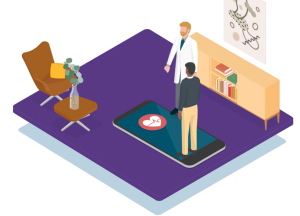Driving health care innovation in 10 steps
Health care innovation takes many forms, including advancements in health system models, management practices, information technologies, workflows, and therapies to better meet changing needs and expectations. Disruptive health care innovations are those that create new value by performing better as measured by national quality standards and at a lower cost than existing offerings. By generating additional value, these innovations have the power to transform the industry. As McKinsey & Company wrote, the best companies embed innovation into the fibers of their culture, from the core to the periphery.
Innovation is ingrained in the culture of Kaiser Permanente, which offers a unique integrated approach to health care. Permanente physicians have been innovating to disrupt and transform the health care industry since the 1940s, when Kaiser Permanente’s founding physician Sidney R. Garfield, MD, pioneered a prepayment health care delivery model that not only managed care for people when they were ill but also focused on prevention to keep them well.
Despite the many innovations and advancements in health care over the past 7 decades, widespread adoption of a truly integrated model of care focused on coordination and prevention has been slow in the United States. This matters because the World Health Organization has identified the integration of care and services as an essential element of quality care.
A model for 21st-century care delivery
Today, the American health care system faces unprecedented challenges. Among them is an aging population that will put increasing demand on the U.S. health care system. That trend, combined with skyrocketing health care costs in a largely “fee-for-service” reimbursement system that often rewards the volume of services delivered over health outcomes, makes the structure of the current health care system unsustainable.
Beyond cost implications, identifying and deploying clinical technologies to improve the accuracy and efficiency of medicine supports ethical and compassionate care delivery, qualities that we consider foundational to our care model.
Within this context, Kaiser Permanente is widely recognized as a model for health and health care in America, unique in its ability to provide value-based care at scale, combining medical expertise, advanced technologies, electronic health record systems, coverage, and care delivery to benefit our 12.6 million members in 8 states and Washington, D.C. Every one of our 39 hospitals earned “high performing” recognition in U.S. News & World Report’s 2022 annual report. Fundamental to the success of this care model is the collaboration between Permanente Medical Group physicians and their colleagues at Kaiser Foundation Health Plans and Hospitals to deliver 21st-century medicine spanning the entirety of patient needs, from prevention to cure.
Here are 10 examples of how Kaiser Permanente innovates to provide industry-leading care:
1. Champions value-based health care that links prepayment to group practice
Value-based care aligns financial results with what is best for the patient’s care, with physicians focused on health outcomes. This model creates a culture of accountability for the care of every member of the affiliated health plan. It also gives physicians the freedom to provide the right evidence-based care for each patient to prevent illness and reduce the incidence and effects of chronic disease. In traditional fee-for-service health care, providers are paid per patient visit, treatment, or test performed, regardless of effectiveness of care.
 A focus on prevention has resulted in high performance on key care measures tracked by HEDIS® (Healthcare Effectiveness Data and Information Set), which often rates Kaiser Permanente in the top 5 to 10% of health plans nationally for preventive measures. These measures include screening for breast cancer and cervical cancer, controlling high blood pressure, and comprehensive diabetes care — including retinal eye exams, blood sugar, and blood pressure control. Permanente physicians are also leading the expansion of innovative preventative services, such as at-home colorectal cancer screening, through a non-less invasive assessment known as FIT (fecal immunochemical test) instead of a colonoscopy for patients aged 45 to 75.
A focus on prevention has resulted in high performance on key care measures tracked by HEDIS® (Healthcare Effectiveness Data and Information Set), which often rates Kaiser Permanente in the top 5 to 10% of health plans nationally for preventive measures. These measures include screening for breast cancer and cervical cancer, controlling high blood pressure, and comprehensive diabetes care — including retinal eye exams, blood sugar, and blood pressure control. Permanente physicians are also leading the expansion of innovative preventative services, such as at-home colorectal cancer screening, through a non-less invasive assessment known as FIT (fecal immunochemical test) instead of a colonoscopy for patients aged 45 to 75.
2. Practices integrated care that encourages collaboration and communication among multiple doctors, health care professionals
The broader American health care system is often fragmented, meaning patients are treated by multiple physicians who don’t coordinate with each other. Physicians, insurers, and medical facilities generally operate independently, which discourages coordination and fosters miscommunication. As a result, patients often need to go from treatment to the pharmacy to rehabilitation in various locations, with medical records and systems of care that do not travel with them.
The solution to his fragmented model of health care is to develop integrated models that bring these services together, allowing for seamless care delivery.
Kaiser Permanente’s model integrates nonprofit health plans and hospitals with 8 multispecialty medical groups, which lets these entities work together to coordinate the entire continuum of care services for patients. Regional efforts are connected through national organizational structures, so physicians can share and spread best practices across the whole system.
Our same-day joint replacement is a good example of a procedure that benefits from integrated care. It includes a suite of best practices for pre-and post-joint replacement surgery gathered from across Kaiser Permanente and bundled in an implementation guide. The program dramatically increased the number of patients who went home safely on the same day of hip or knee replacement surgery. As a result, the percentage of joint-replacement patients who avoided an overnight hospital stay without any increased risk of complications went from 7.2% in 2016 to 78% in 2022.*
3. Engages physician leaders in all aspects of decision-making
Physician leadership ensures that clinical judgment leads in system design and individual patient care, resulting in better patient outcomes, clinical performance, and professional satisfaction. In a typical fragmented health system, physicians have limited decision-making authority. Permanente physicians work in an integrated care approach that fosters innovation. Two examples include providing hospital care at home at scale and rapidly moving to prescribing evidence-based biosimilars to make prescriptions less expensive.
Telehealth services also empower patients to prioritize their health and help prevent delays in seeking and obtaining care. It also improves access for members who live in remote areas or those who cannot easily leave their homes.
— Edward Lee, MD, chief information officer, The Permanente Federation
4. Supports independent, multi-specialty medical groups that innovate and collaborate across specialties and geographies
Teams of professionals who specialize in different areas, such as cardiology, oncology, and infectious diseases, are an essential element of an integrated model of care. Permanente Medical Groups’ emphasis on collaboration among different specialties and between primary care and specialty physicians enables more convenient, personalized, and high-quality care.
For example, Kaiser Permanente’s Excellence in Cancer Care expert consultation program brings together regional Permanente oncology experts and specialists from across the country to collaborate on the best cancer care options for patients with complex or rare cancers.
 5. Invests in electronic medical records that support coordinated care
5. Invests in electronic medical records that support coordinated care
Electronic health records play a pivotal role in creating a more efficient and effective health care system. By bringing together a patient’s medical history, diagnoses, medications, treatment plans, vaccine history, radiology images, lab results, and more in one accessible place, physicians and clinicians can easily track and update the patient’s medical history at any touch point, facilitating coordinated care across the organization.
Kaiser Permanente led the industry as an early innovator of electronic medical records, beginning in 1960. Since then, Kaiser Permanente’s electronic health record has evolved into one of the largest private medical record systems in the country, securely connecting more than 12.6 million people to their physicians and care team, personal information, appointment and screening reminders, and the latest medical knowledge.
6. Grows industry-leading telehealth capabilities
Devices such as telephones, smart phones, computers, and tablets have revolutionized medical practice by enabling physicians and medical-support staff to care for patients without an in-person visit. Particularly during the height of the COVID-19 pandemic, when hospitals were overcrowded and patients with routine health issues were advised to remain at home, health care professionals at Kaiser Permanente reimagined health care by delivering a wide array of health products and services into patients’ homes.
A value-based, prepaid care model encourages long-term investments in innovative technologies, as demonstrated decades ago with the introduction of telehealth capabilities at Kaiser Permanente. In the late 1990s, Permanente physicians and clinicians started using telehealth to deliver convenient, high-quality, patient-centered care as a seamless component of its integrated care model — not as an add-on service. Telehealth capabilities such as telephone visits, e-visits, secure email exchanges, online chat with clinicians, remote patient monitoring, and Tele-Critical Care in ICU settings increase access and convenience with the goal of providing the right care at the right time and in the right place on behalf of those we serve.
7. Brings high acuity care into patients’ homes
Just as it is often easier and better for patients to receive care virtually, it is frequently safer and more convenient for many patients to receive a mix of in-person and virtual high-acuity care in the comfort of their own homes. The need for advanced care at home became apparent during the COVID-19 pandemic, when much of the nation experienced hospital bed shortages. Long before the pandemic, Kaiser Permanente had started innovating the delivery of acute-level health care services in peoples’ homes.
 Today, Permanente physicians lead advanced care-at-home programs in California, Oregon, Washington, and Georgia, where they collaborate with skilled teams of nurses and other medical-support professionals to deliver a blend of in-person visits, telehealth services, and remote monitoring. These programs deliver high-quality care to patients with serious conditions, such as congestive heart failure, strokes, and pneumonia, and provide care for those with chronic conditions, such as COPD (chronic obstructive pulmonary disease), diabetes, and hypertension, which, with the support of the technologies, supplies, and care coordination protocols, Kaiser Permanente can treat and manage in the home without a hospital admission.
Today, Permanente physicians lead advanced care-at-home programs in California, Oregon, Washington, and Georgia, where they collaborate with skilled teams of nurses and other medical-support professionals to deliver a blend of in-person visits, telehealth services, and remote monitoring. These programs deliver high-quality care to patients with serious conditions, such as congestive heart failure, strokes, and pneumonia, and provide care for those with chronic conditions, such as COPD (chronic obstructive pulmonary disease), diabetes, and hypertension, which, with the support of the technologies, supplies, and care coordination protocols, Kaiser Permanente can treat and manage in the home without a hospital admission.
Patients who received care through at-home programs have experienced fewer complications, such as hospital-acquired infections, incidence of delirium, and falls. They also experienced improved physical function and have lower readmission rates. High patient satisfaction scores demonstrate the program’s ability to deliver safe, high-quality care in a setting preferred by patients.
8. Advocates for health equity
Providing care to all is a principle from which Kaiser Permanente has never wavered since its founding in the 1940s, when it was among the first care providers in the United States to have racially integrated hospitals and waiting rooms, as well as an ethnically diverse workforce, including physicians and allied health professionals.
This focus on equity extends to addressing differences in the burden of disease across different populations. For years, Permanente physicians have focused on reducing and even eliminating health disparities among racial and ethnic groups. For example, hypertension control for Black members at Kaiser Permanente is 60% better than the national average. Similarly, Kaiser Permanente ranks in the top 5% in the nation for cervical cancer screening and has eliminated meaningful disparities in cervical cancer rates for the diverse populations we serve.
9. Applies remote patient monitoring in new ways to manage acute and chronic conditions
Remote patient monitoring combines leading-edge technology with clinical expertise to track and relay information about a patient’s health from their own home, an increasingly popular telehealth option. For example, many Kaiser Permanente members who have diabetes or hypertension use prescribed Bluetooth-enabled glucometers and blood pressure monitors — along with a free smartphone app — to transmit readings in real time directly to their electronic medical record. Using the app, members can share notes that provide further insight if a reading is higher or lower than the desired range.
High blood pressure, or hypertension, is also linked to a range of complications in pregnancy, from increased risk of seizures to preterm birth and even death. Black women in the United States are 2 to 3 times more likely to die from pregnancy-related causes than white women, due in part to underlying conditions such as hypertension. Lessons learned from offering telehealth during the pandemic — paired with a program focused on Black maternal health and high-risk pregnancies at Kaiser Permanente in Georgia — informed a new Kaiser Permanente perinatal care model that offers remote blood pressure monitoring for all pregnancies.
10. Focuses on physician wellness
Improving operational efficiencies is a critical ingredient to supporting physician and clinician wellness. Interest in this skyrocketed during the COVID-19 pandemic, when many physicians experienced record levels of stress and burnout.
A key example of a process improvement that both helps physicians’ workflow and benefits patients is an earlier initiative using artificial intelligence (AI) capabilities to screen messages sent to a physician’s in box in the electronic health record. By sorting through messages and directing it to the right care team member, whether it’s helping to find a facility or questions about prescriptions, this allows the physicians to focus on patient care.
 These 10 examples provide only a small sampling of the many ways Kaiser Permanente and Permanente physicians who leverage the capabilities and resources of the organization improve the lives of our patients. We will continue to apply the same dedication to innovation we have when caring for patients to creating a workplace where our teams can thrive. To learn more, visit our health care innovation page.
These 10 examples provide only a small sampling of the many ways Kaiser Permanente and Permanente physicians who leverage the capabilities and resources of the organization improve the lives of our patients. We will continue to apply the same dedication to innovation we have when caring for patients to creating a workplace where our teams can thrive. To learn more, visit our health care innovation page.
* “Same-Day Joint Replacement Care: Achieving the Quadruple Aim,” NEJM Catalyst: Innovations in Care Delivery